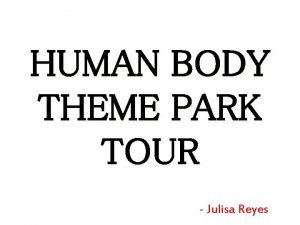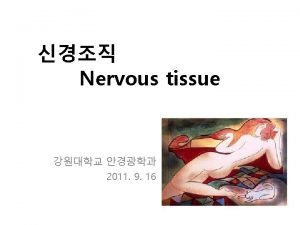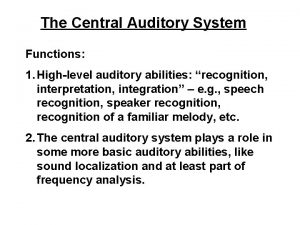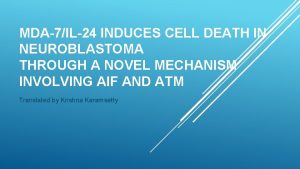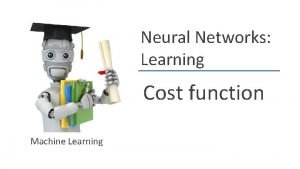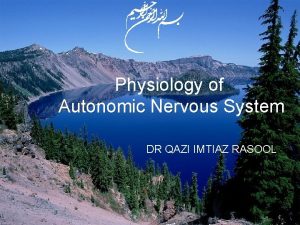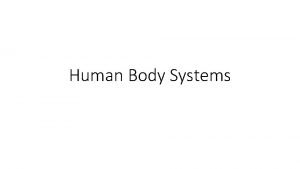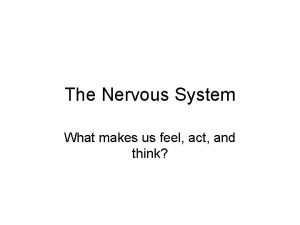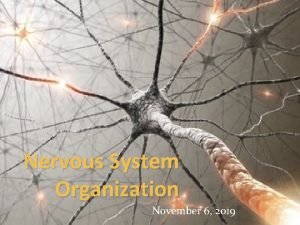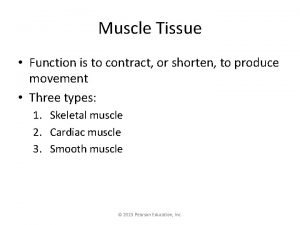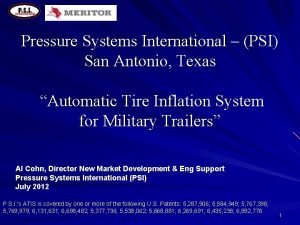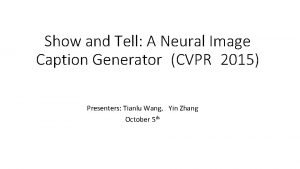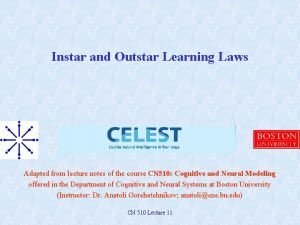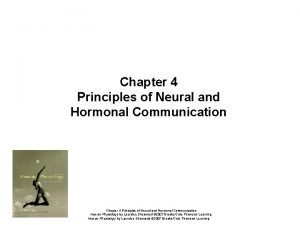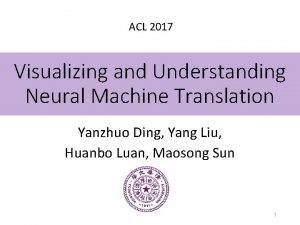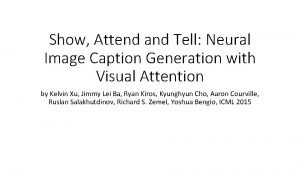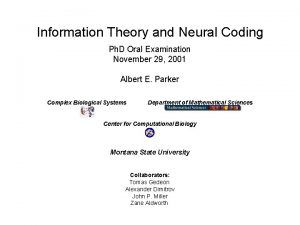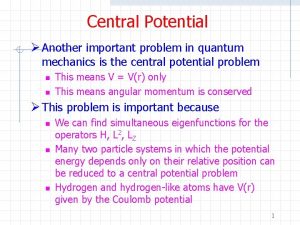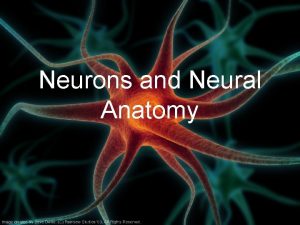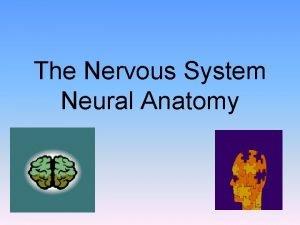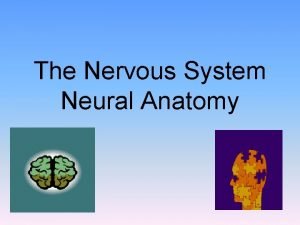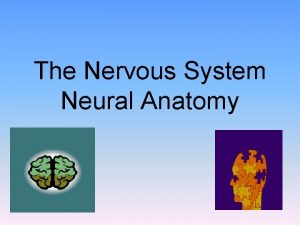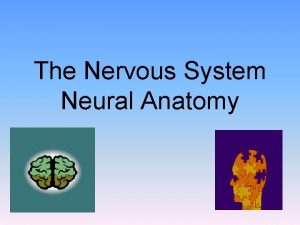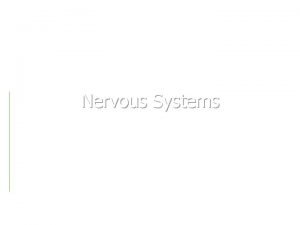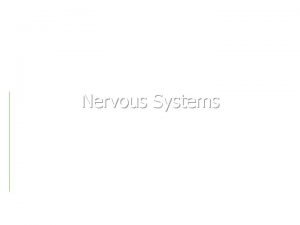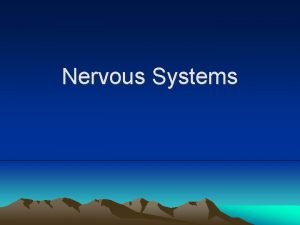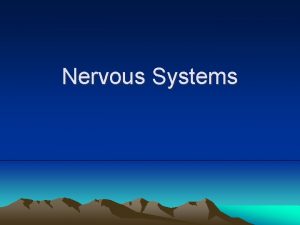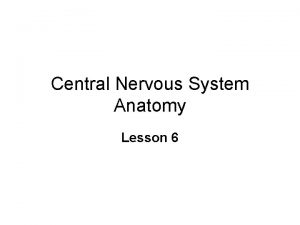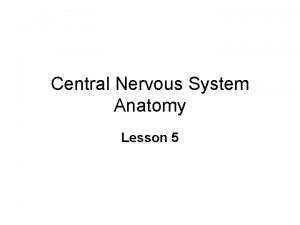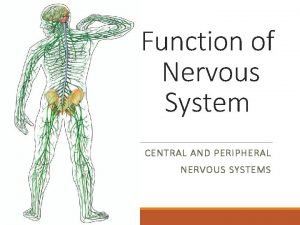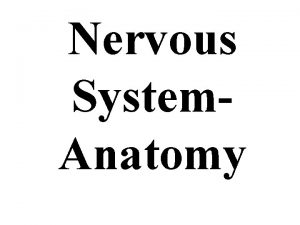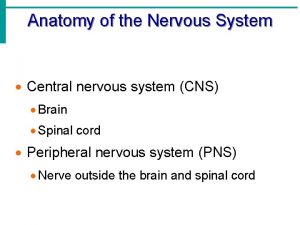Neural Anatomy and Function NERVOUS SYSTEMS Central nervous











































- Slides: 43

Neural Anatomy and Function

NERVOUS SYSTEMS • Central nervous system • Peripheral nervous system

CENTRAL NERVOUS SYSTEM p. 33 • Brain – Cerebral Cortex/Cerebrum • Motor cortex – Basal Ganglia/Diencephalon – sensory input – Cerebellum – motor control – Brain stem – sensory input • Spinal Cord

PERIPHERAL NERVOUS SYSTEM • Somatic – Sensory (Gamma) Nerves – Motor (Alpha) Nerves • Autonomic [FYI] – Parasympathetic – Sympathetic

Spinal Nerves p. 35


NERVE ANATOMY • A single nerve cell is called a neuron • A bundle or group of neurons make up a nerve • A nerve contains both afferent and efferent nerves

Afferent Neuron • Carry impulse towards the CNS (e. g. sensory nerves) • Synapse Towards CNS

Efferent Neuron • Carry impulse away from the CNS (e. g. motor nerves) 1. Stimulatory 2. Inhibitory

NEURON ANATOMY • Dendrite • Cell Body • Axon

AXON 1. 2. 3. 4. Conduction Myelin sheath Synapse Neurotransmitter

CONDUCTION Resting State: Na outside, K inside

CONDUCTION 4. Na K Pump 3. Repolarization 1. Depolarization 2. Propagation

MYELIN SHEATH

SYNAPSE

SYNAPSE

SYNAPSE • Quick Time Movie

NEUROMUSCULAR JUNCTION

NEUROMUSCULAR JUNCTION


MOTOR UNIT • Motor unit = one motor nerve + all the muscle fibers it innervates. • Types – Fast (alpha -1) – Slow (alpha -2)

3 1 2

MOTOR UNIT Fast Slow

MUSCLE TENSION or FORCE or STRENGTH 1. Number of MU stimulated 2. Frequency of stimulation to each MU 3. Type of MU stimulated

MUSCLE STIMULATION: How does it begin?

1. Volitional Control (Motor Cortex) 1. Motor cortex 2. Motor neurons 3. Muscles

2. Reflex Control 1. Afferent neuron – Sensory neuron 2. Efferent neuron – Motor neuron


PROPRIOCEPTION & KINESTHESIS p. 37 • Proprioception – The ability to sense the position and location and orientation and movement of the body and its parts • Kinesthesis – The ability to feel movements of the limbs and body

PROPRIOCEPTION • Proprioceptors of the joints and skin – Meissner’s corpuscles – Ruffini’s corpuscles – Pacinian corpuscles – Krause’s end-bulbs

PROPRIOCEPTION • Proprioceptors of the muscles – Muscle spindles – Golgi tendon organs

Muscle Spindles

muscle spindle


Muscle Spindles • Provide proprioception • Sense the amount of stretch and the rate of stretch • Reflexes involving the muscle spindles is how we ‘feel’ a movement was done correctly • Spindles are a part of learning; we develop such reflexes as we practice skills and movements

Golgi Tendon Organs


Golgi Tendon Organs • Sensitive to muscle tension and active contraction • Protect muscle from excess contraction force • Stimulation of GTO an afferent impulse is sent to the central nervous system • In turn, efferent impulses are sent to the… – Agonist muscle causing it to relax – Antagonist muscle causing it to contract

Neuromuscular Summary • An example from baseball. • A pitcher throws a curve ball to Sammy Sosa • Sammy’s eyes see the ball coming towards him and is able to identify the pitch as a curve ball • Sensory nerves (afferent) send that information to the CNS • In the CNS the sensory nerve synapses with motor nerves • The motor nerves in turn stimulates the muscles (deltoid and pectoralis major) required to swing the bat in the proper position to hit the ball

Neuromuscular Summary • Inside the fibers of the deltoid and pectoralis major, calcium is released • The calcium allows myosin heads to attach to actin • When the heads swivel the fibers of the deltoid muscle will shorten • The shortening of the fibers will pull on the humerus causing Sammy to swing the bat • The muscle spindles “tell” the CNS when the arm is in the correct position • If all goes as planned, the deltoid and pectoralis major will move his arms into a position to hit the ball

Neuromuscular Summary • An example from weight training. • A man is having his muscular strength tested on the bench press • For his first lift, 50 pounds is put on the bar • He will be using his pectoralis major muscle with has 500 motor units (300 slow twitch and 200 fast twitch) and his triceps muscle • His CNS stimulates 280 motor units leading to his pectoralis major muscle (180 slow twitch and 100 fast twitch) • End nerve ending stimulates a separate muscle fiber

Neuromuscular Summary • Calcium is released, myosin attaches to actin and swivels. • The pectoralis major and triceps muscles shortens and his arm extends outward raising the bar with 50 pounds on it. • After a few minutes of rest, 100 pounds is place on the bar • This time he stimulates 380 motor units (260 slow twitch and 120 fast twitch) • The weight is successfully lifted • After a few minutes of rest, 150 pounds is place on the bar

Neuromuscular Summary • This time he stimulates 460 motor units (280 slow twitch and 180 fast twitch) • As the pectoralis major muscle contracts the GTO in the pectoralis major are stimulated • They stimulate a sensory nerve leading to the CNS • In the CNS, the sensory nerve synapses with a motor nerve that will inhibit (relax) the pectoralis major muscle • The man is unable to successfully lift the 150 pounds.
 Neuronal pools
Neuronal pools Fundamentals of the nervous system and nervous tissue
Fundamentals of the nervous system and nervous tissue Neuronal pools are collections of
Neuronal pools are collections of Division of central nervous system
Division of central nervous system Hydras
Hydras Chapter 14 skeletal muscular and nervous systems
Chapter 14 skeletal muscular and nervous systems Module 10 the nervous and endocrine systems
Module 10 the nervous and endocrine systems Central nervous system amusement park
Central nervous system amusement park Central nervous sysytem
Central nervous sysytem Image of central nervous system
Image of central nervous system Nervous system vocabulary
Nervous system vocabulary Central auditory nervous system
Central auditory nervous system Electrical synapse vs chemical synapse
Electrical synapse vs chemical synapse Central nervous system for kids
Central nervous system for kids Cost function neural network
Cost function neural network Prevertebral ganglia
Prevertebral ganglia Interoreceptor
Interoreceptor Nervous interactions with other systems
Nervous interactions with other systems Nervous system function
Nervous system function Function of the nervous system
Function of the nervous system Type of muscle
Type of muscle External nares frog
External nares frog Frog organs
Frog organs Decision support systems and intelligent systems
Decision support systems and intelligent systems Psi san antonio
Psi san antonio Visualizing and understanding convolutional neural networks
Visualizing and understanding convolutional neural networks Show and tell a neural image caption generator
Show and tell a neural image caption generator Mippers
Mippers Pigmented layer and neural layer
Pigmented layer and neural layer Pearson
Pearson Least mean square algorithm in neural network
Least mean square algorithm in neural network Instar law
Instar law Neural and hormonal communication
Neural and hormonal communication Neural networks for rf and microwave design
Neural networks for rf and microwave design Visualizing and understanding neural machine translation
Visualizing and understanding neural machine translation Show attend and tell
Show attend and tell Fuzzy logic lecture
Fuzzy logic lecture Neural networks and learning machines
Neural networks and learning machines Information theory and neural coding
Information theory and neural coding Central potential is a function of
Central potential is a function of Function of central business district
Function of central business district Engineering elegant systems: theory of systems engineering
Engineering elegant systems: theory of systems engineering Embedded systems vs cyber physical systems
Embedded systems vs cyber physical systems Elegant systems
Elegant systems







